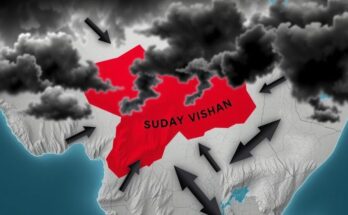The Sayida Zaynab shrine has transitioned from a significant Shia pilgrimage site to a focal point of sectarian struggles and emerging power dynamics in post-Assad Syria. Abu Omar, the head of security, leads efforts to protect the local Shia community amidst ongoing tensions with remnants of the previous regime. The situation in Douma reflects similar themes of distrust and the urgent need for reconciliation, emphasizing the complexity of societal interactions in a fractured nation pursuing hope for peace and stability.
The Sayida Zaynab shrine, located outside Damascus and revered by Shia Muslims, has transformed from a pilgrimage site to a stronghold of Shia militias during the civil war. Currently, it symbolizes a new regime characterized by both fear and hope. Abu Omar, the shrine’s head of security, represents the new order, aiming to protect the Shia community and push back against remnants of the previous regime. He asserts the need for vigilance in combating past influences while fostering a secure environment for all residents.
Abu Omar and his Sunni team strive to maintain safety in the shrine’s vicinity. Despite the optimism they embody, underlying tensions persist among different sectarian groups in Syria. Residents reflect on a fragmented society, underscored by potential revenge-driven motives against the supporters of the old regime. Abu Omar emphasizes his dedication to safeguarding the Shia population, suggesting a profound commitment to unity that transcends sectarian loyalties.
Showcasing a belief in reconciliation, Deeb Krayem, a Shia manager, expresses hope in the ideals promoted by the new regime, although his apprehensions linger. Following unsettling incidents and a sense of fear regarding sectarian alignment, many express their doubts about sustained peace. In contrast, Shia mourners at the shrine hold complex sentiments, asserting a longing for coexistence while critiquing the perceived injustices experienced by their community throughout the conflict.
Similarly, certain Alawite individuals harbor fears of retribution stemming from sectarian tensions, depicting an environment of distrust even among those who wish for peace. Amidst recollections of violence, they advocate for mutual accountability, suggesting that true reconciliation necessitates the acknowledgment of both sides’ pasts.
The situation in Douma, a former stronghold of resistance, illustrates further divisions as individuals who supported the revolution contend with returning community members. An estimated 350,000 to 400,000 people now inhabit Douma, yet infrastructure damage presents persistent challenges. Local leaders work to re-establish order amidst the strain of restoring the displaced populace and addressing the mistrust that fuels tensions between varying factions.
Despite the daunting circumstances, many residents long for stability and express resilience in the transition towards a new social order. The complexities of coexistence in a divided society echo through various testimonies, emphasizing the need for dialogue over retelling the past. Ultimately, individuals remain hopeful about their future, advocating for a cohesive and just Syrian state where all voices can thrive without the burden of previous regimes’ legacies.
The situation within Syria, particularly surrounding the Sayida Zaynab shrine and Douma, illustrates the multifaceted challenges faced in a post-Assad landscape. While both fear and hope characterize the new regime, local leaders and residents underscore the importance of safeguarding communities from sectarian violence. The desire for coexistence remains strong, with numerous individuals advocating for understanding and shared progress, even in the face of adversity. Acknowledging the past and striving for a new order will be crucial for Syria’s future.
Original Source: tcf.org




